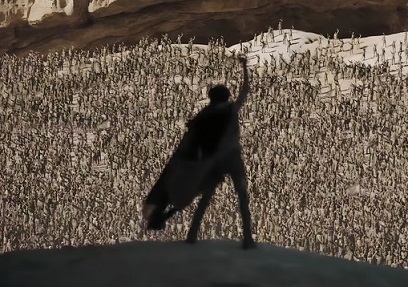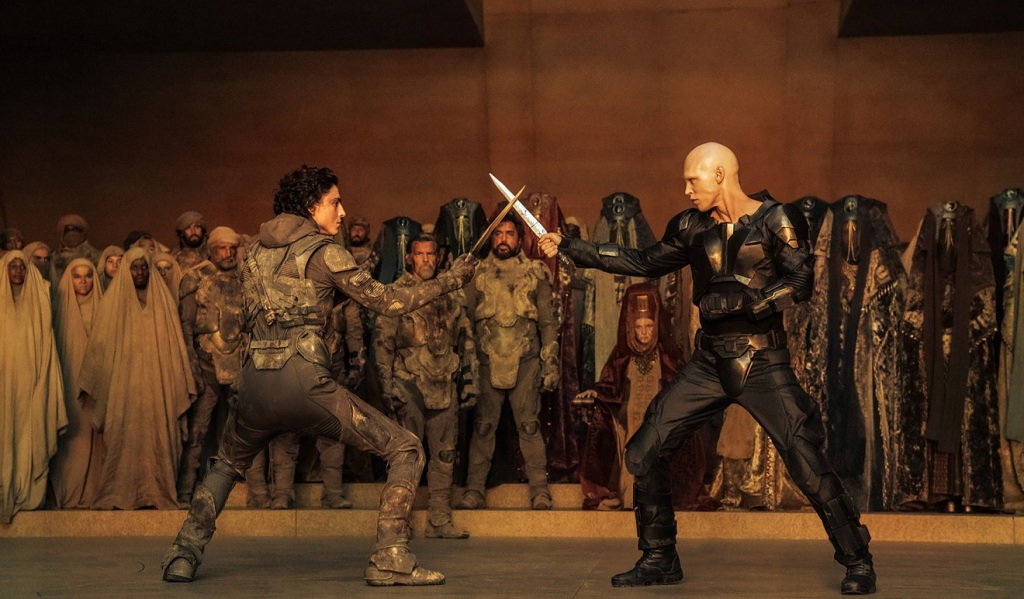Dune began its life as a deliberately incomplete project, with writer/director/producer Denis Villeneuve insisting on adapting the famous novel in two parts, but only securing funding for one of those parts, with a follow-up film contingent on its success. There are several problems with this approach, but Dune was successful enough – well, no it wasn’t. Its box office performance certainly didn’t warrant a sequel, but that was hindered by Warner Bros.’ unilateral decision to release all its 2021 movies day-and-date on HBOmax, so executives gave it a handicap and took all its technical Oscars into account. They’ve all been sacked, that’s not even what the god damn website’s called anymore, everything’s much worse now – whatever logic was used, someone decided this was worth another $190 million, so here we are.
Ironically, this is not the first attempt at adapting “Dune” to film that is known to be incomplete – David Lynch’s 1984 adaptation ran out of money in the middle of production, leaving an obviously incomplete film relying on cheap “Star Trek” style sets that starts skipping like a broken record halfway through, fortuitously at almost the precise point part one of Villeneuve’s adaptation cuts off. This second part is the realization of not just the last film, but more than 50 years of trying to bring this novel to the screen.
The Galactic Padishah Empire, 10191- House Harkonnen’s assault on Arakeen has completely exterminated House Atreides, re-establishing control over Arrakis, the brutal desert planet informally referred to as “Dune” that is the only natural source in the universe of the spice Melange, which makes interstellar travel possible, but something has changed. Guerilla attacks from the indigenous Fremen population, now led by a mysterious prophet called Paul Muad’Dib (Timothée Chalamet), are now so much more effective they’ve ground spice production to a halt. The situation has become so dire that Shaddam IV, Emperor of the Known Universe (Christopher Walken), is coming to Arrakis personally to get them back on schedule.
In many ways, a film’s setting contains its entire story, and the incredible ambition of bringing the complex and extraordinary “Dune” universe to life can’t be ignored. Last year, Oppenheimer and Killers of the Flower Moon showed us the impact of close-ups on Oscar-worthy performances blown up to IMAX scale, but Dune isn’t about all that. Dune is about massive-scale wide shots with hundreds of extras on custom-built sets, the kind of production you’d hope to see once a year back in the Golden Age. It takes a small army to make any production film, but in Dune, there’s a decent-sized army in front of it, in full dress that had to be imagined from the ground up. It was shot digitally, but they’ve printed 70mm reels so that level of physicality can exist, if only on 12 screens in the entire world.

Most impressive in part two is the astonishing high-contrast black-and-white sequence on Geidi Prime, the Harkonnen homeworld, which introduces Feyd-Rautha Harkonnen (Austin Butler), Paul’s rival and cosmic counterpart. This striking look is created to cover an entire arena as Feyd-Rautha slaughters prisoners to celebrate his birthday, and goes on into the evening of black and white fireworks.
Dune does a wonderful job of expressing the technology and religious values of its fantasy world through exciting action scenes, which allow it to cut down on blathering and present this staccato collection of action sequences as a narrative. Highlights in part two include Paul’s first worm ride and the guerilla attack scene where Gurney Halleck (Josh Brolin) is reintroduced, but there are missed opportunities here. Early in the film, Paul is sent on a monthlong walk into the desert as his first trial to join the Fremen, and the film just cuts away. We see him walk off, and then suddenly he’s back again. The elongated sensory overload of Paul’s first ride is never revisited, and the film seems to develop a sandworm deficit as all other riding is shot from a great distance that makes the practice seem trivial.
As striking as the Geidi Prime sequence is, it feels like it’s missing a lot of the same opportunities. This was a chance to dig further into Harkonnen culture and customs, which would come in the same film that we learn how entwined House Harkonnen and House Atreides really are. We get that imagery and the brutality and ruthlessness that were already present, but there’s so much removed from this sequence – the traditions of cannibalism and pedophilia and Feyd-Rautha’s plot to assassinate Baron Valdimir Harkonnen (Stellan Skarsgård) are only ever hinted at. They even bring in a Bond girl to play Margot Fenring (Léa Seydoux), a Bene Gesserit Imprinter assigned to seduce Feyd-Rautha and ensure he has descendants, but the film cuts away as soon as they get to the bedroom.
As much as Dune is about these massive-scale action scenes, I can’t stand the individual combat. The knife-fighting choreography has the ultra-cool shield concept going for it, but many of the fights end up looking dumb. There’s way too much flipping and ballet and not enough interacting with the shield itself, a missed opportunity for brutal, bloody combat to match the brutal, bloody world the film describes, but fails in many ways to depict.
The biggest offenders are the film’s climactic duels, when Paul takes on Jamis (Babs Olusanmokun) in part one and Feyd-Rautha in part two in shield-free contests. The style shifts, and all combatants seem to be moving their limbs and torsos independently of each other, all at extreme speed to give the impression of complexity – it’s hard to describe, but it doesn’t look futuristic as much as it looks like play-fighting. The duel with Feyd-Rautha in particular has much more background and takes a completely different path in the novel.
It’s impossible to properly contextualize part two of Dune without going into detail on the hard sci-fi plot points it includes and how it approaches them, so detailed spoilers below.
***

The two parts of Dune are separated by a two-year timeskip in the novel, but this skip is after Lady Jessica (Rebecca Ferguson) drinks the Water of Life, a potentially deadly agony to increase her psychic powers so she can serve as Arrakis’ primary religious leader. This ritual awakens powers equal to her own in her unborn child, whom she immediately births in the book right there during the water ceremony. The child, Alia Atreides, accelerates her own growth and immediately becomes a major asset – this is one of the most painfully memorable moments of Lynch’s adaptation.
In part two of this Villeneuve attempt, there is no timeskip, and Alia doesn’t shoot out during the ceremony – Jessica isn’t showing when the film starts, but appears to be in her third trimester by the end of the film, so this is all over the course of a few months. The ceremony does awaken the child’s consciousness, however, so there are several scenes of Jessica speaking psychically with the fetus in her belly, whose speech is played over creepy, IMAX-sized footage of fetal tissue. Alia Atreides (Anya Taylor-Joy) appears fully grown in one of Paul’s visions.
It would have been simple and much more graceful to restructure this as a harder action film with more scenes exploring Fremen and Harkonnen cultures punctuated by Jessica’s and Paul’s Water of Life ceremonies. The first leg could take several months and feature Alia’s birth, then present a timeskip with an adult actress making a joke about only being 2 years old.
Denying viewers a demented Bene Gesserit sex scene among so much else, part two of Dune feels again like there’s some beancounter perched on Villeneuve’s shoulder telling him what he can and can’t put onscreen. A lot of what’s specifically missing in Dune, like sexual assault, violent birth scenes and human-animal hybrid monsters, are present in the rest of his English-language filmography, but these are his first PG-13 films, and they’re following up Blade Runner 2049, a hard R sci-fi epic that lost $80 million despite being an unquestionable masterpiece.
2049 also hinges on a possible messiah figure grappling with his destiny, and Arrival, his film before that, also has a lead character who can see all of time at once and must choose whether or not to complete her destiny. It’s frustrating to be told that Dune was too original of an idea to fit into a single film when there’s such specific overlap in Villeneuve’s prior work, but he’s a massive fan of the novels and the saying goes that directors keep making the same film over and over again, so it shouldn’t be a surprise that he leaned on these ideas to build his career up to the point that he can pull this type of budget. The bottom line, though, is Dune isn’t Villeneuve’s uncompromised vision for this novel – Blade Runner 2049 is closer to what that would look like.
Heartbreakingly, and somewhat perplexingly, the result is a Dune that shares many of the harsher problems with Lynch’s attempt, albeit in a much higher quality film. For all its grand wide shots, we also see a lot of the same cramped “Star Trek” sets where all the actors are stacked on top of each other trying to act like it’s a much more spacious room. Its handling of Alia Atreides isn’t any less weird.

In 2021, the explanation for cutting this film in half was there’s too much ground to cover in “Dune” for a single film, and then part one releases as this slow film that doesn’t cover a ton of ground. Now, the explanation is Dune needed to be an established success before piling on the weird stuff, but part two releases as a film that leaves out a lot of the weirder stuff.
Alternatively, if the point is to infuse humanity and relatability into this alien story, Dune moves away from that in part two as well. Paul is the heart of this story, a hyper-competent protagonist who feels trapped by a destiny that he can see, but can’t escape. His anxiety fills the story, but after he takes the Water of Life, everything human about him is gone. His every line is shouted, and his fear of the holy war he heralds vanishes without a word. This terrible thing was always going to happen to him, but Dune seems to lose interest in the Greek tragedy of it all at just the moment when it becomes tragic.
I guess it’s OK because they’ll refocus on the tragic aspects of Paul’s narrative in part three? Oh, come off it!
The screenplay for a third film based on “Dune Messiah,” which concludes Paul’s story, is already complete, and I’m sure that’ll be just as big and epic and colorful as Dune. Maybe it’ll actually feel like a complete movie this time.
Leopold Knopp is a UNT graduate. If you liked this post, you can donate to Reel Entropy here. Like Reel Entropy on Facebook and reach out to me at reelentropy@gmail.com.


Pingback: Living with the phantom of ‘The Phantom Menace’ | Reel Entropy